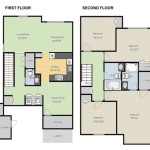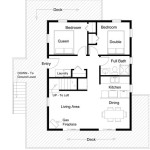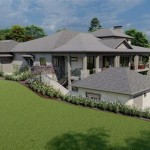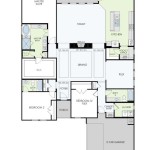House Plans with Wrap Around Porch: A Single Story Perspective
The allure of a wrap-around porch is timeless. It evokes images of simpler times, offering a space for relaxation, socializing, and enjoying the outdoors from the comfort of home. When combined with the convenience and accessibility of a single-story house plan, the appeal is further amplified. This article examines various aspects of house plans featuring wrap-around porches on single-story homes, exploring design considerations, benefits, and practical implementations.
A wrap-around porch is defined by its ability to extend along two or more sides of a house, effectively "wrapping" around a significant portion of the structure. This design element contributes significantly to the aesthetic appeal of the home, providing a visual link between the indoor and outdoor spaces. Single-story house plans, in turn, offer ease of movement and accessibility, eliminating the need for stairs and making them suitable for individuals of all ages and mobility levels. The combination of these two features results in a living space that is both functional and aesthetically pleasing.
The historical context of wrap-around porches is rooted in the desire to create shaded outdoor spaces in warmer climates. Before the widespread adoption of air conditioning, porches provided a respite from the heat and a place to catch a breeze. In the southern United States, particularly, wrap-around porches became a defining characteristic of vernacular architecture. However, the appeal of these porches extends beyond climate considerations, offering a sense of community and connection to the surrounding environment regardless of location.
Design Considerations for Single-Story Homes with Wrap-Around Porches
Designing a single-story home with a wrap-around porch requires careful consideration of several factors, including site orientation, porch dimensions, material selection, and the integration of the porch with the interior layout. The orientation of the house on the lot is crucial for maximizing the benefits of the porch. Ideally, the porch should be positioned to take advantage of prevailing winds and provide shade during the hottest part of the day. This can significantly reduce the need for artificial cooling, contributing to energy efficiency.
The dimensions of the porch are also important. A porch that is too narrow may feel cramped and limit its usability, while a porch that is too wide may detract from the overall proportions of the house. A typical porch width ranges from 8 to 12 feet, providing ample space for seating, dining, and other activities. The height of the porch ceiling should also be considered, as a low ceiling can create a claustrophobic feeling. A minimum ceiling height of 8 feet is generally recommended, with higher ceilings favored in warmer climates to promote air circulation.
Material selection plays a significant role in the aesthetic and functional aspects of the porch. Wood is a popular choice for porch decking and railings, offering a warm and inviting appearance. However, wood requires regular maintenance to prevent rot and decay. Composite decking materials provide a low-maintenance alternative that mimics the look of wood while being more resistant to the elements. For porch columns and supports, options include wood, fiberglass, and brick. The choice of materials should be consistent with the overall architectural style of the house.
The integration of the porch with the interior layout is essential for creating a seamless transition between indoor and outdoor spaces. Large windows and doors opening onto the porch can blur the boundaries between the two, creating a sense of spaciousness and connection to nature. Consider incorporating multiple access points to the porch from different rooms in the house, such as the living room, dining room, and bedrooms. This allows for easy access and encourages the use of the porch as an extension of the living space.
Accessibility is a vital consideration for single-story homes, particularly those designed for aging in place. Ensure that the porch has a level entry or a ramp to accommodate wheelchairs and other mobility devices. Wide doorways and clear pathways on the porch will also enhance accessibility. The use of non-slip flooring materials is recommended to prevent falls. Handrails should be installed along the perimeter of the porch for added safety and support.
Benefits of Single-Story House Plans with Wrap-Around Porches
The benefits of incorporating a wrap-around porch into a single-story house plan are numerous, extending beyond aesthetic considerations. These benefits encompass improved energy efficiency, increased living space, enhanced property value, and a stronger connection to the surrounding environment.
A wrap-around porch can contribute to energy efficiency by providing shade to the walls and windows of the house. This reduces the amount of heat that enters the building, lowering the demand for air conditioning in warmer months. In cooler climates, the porch can act as a buffer against cold winds, helping to insulate the house and reduce heating costs. The orientation of the porch, as previously mentioned, is crucial for maximizing these energy-saving benefits.
The porch effectively increases the living space of the house by providing an outdoor room that can be used for a variety of purposes. It can serve as a dining area, a relaxation space, a play area for children, or a place for entertaining guests. The versatility of the porch makes it a valuable addition to the home, particularly for those who enjoy spending time outdoors. The addition of outdoor furniture, such as comfortable seating, tables, and lighting, can further enhance the usability of the porch.
A well-designed and maintained wrap-around porch can significantly enhance the property value of a single-story home. It adds curb appeal and creates a positive first impression for potential buyers. The porch is often seen as a desirable feature that adds character and charm to the house. In some markets, a wrap-around porch may be a significant selling point, attracting buyers who are looking for a home with outdoor living space.
The wrap-around porch fosters a stronger connection to the surrounding environment. It provides a place to observe nature, enjoy the fresh air, and connect with neighbors. This connection to the outdoors can have a positive impact on mental and physical well-being. The porch can become a focal point for social interaction, fostering a sense of community and belonging. It provides a space for casual conversations, gatherings, and impromptu visits from friends and neighbors.
Practical Implementations and Style Variations
The practical implementation of a wrap-around porch on a single-story home can vary depending on the architectural style of the house and the specific needs of the homeowner. There are numerous style variations to choose from, ranging from traditional to contemporary, each offering a unique aesthetic and functional appeal.
Traditional styles, such as Victorian and Colonial, often feature ornate details, such as decorative columns, intricate railings, and gingerbread trim. These porches are characterized by their elegant and refined appearance. The use of natural materials, such as wood and stone, is common in traditional designs. The layout of the porch typically emphasizes symmetry and proportion.
Farmhouse-style wrap-around porches are known for their simplicity and functionality. They often feature wide plank flooring, sturdy railings, and comfortable seating. The emphasis is on creating a relaxed and inviting space that is perfect for enjoying the outdoors. Farmhouse porches often incorporate elements of rustic charm, such as exposed beams and natural wood finishes.
Contemporary designs offer a more modern and minimalist approach to wrap-around porches. These porches often feature clean lines, simple materials, and a focus on functionality. The use of glass and metal is common in contemporary designs, creating a sleek and sophisticated appearance. Contemporary porches may incorporate features such as outdoor kitchens, fireplaces, and integrated lighting systems.
The addition of screens to the porch can provide protection from insects and the elements, allowing for year-round use. Screened-in porches are particularly popular in areas with high mosquito populations. The screens can be integrated seamlessly into the design of the porch, maintaining its aesthetic appeal. Retractable screens offer the option of opening up the porch to the outdoors when desired.
For homeowners who desire more privacy, landscaping can be used to create a natural barrier around the porch. Planting trees, shrubs, and flowers can provide shade, block unwanted views, and create a more secluded outdoor space. Trellises and climbing plants can also be used to add privacy and enhance the aesthetic appeal of the porch. The landscaping should be carefully planned to complement the architectural style of the house and the overall design of the porch.
Lighting is an essential element of any wrap-around porch design. It not only provides safety and security but also enhances the ambiance of the space. Consider incorporating a variety of lighting fixtures, such as overhead lights, sconces, and landscape lighting, to create a well-lit and inviting atmosphere. Dimmer switches can be used to adjust the lighting levels to suit different occasions.
Ultimately, the design of a single-story home with a wrap-around porch should reflect the individual preferences and lifestyle of the homeowner. By carefully considering the various design elements and practical implementations, it is possible to create a space that is both functional and aesthetically pleasing, providing years of enjoyment and enhancing the quality of life.
:max_bytes(150000):strip_icc()/HOH_SL1482-df5abe9d7ee44f7a9f29e0a7b412b06c.jpg?strip=all)
13 House Plans With Wrap Around Porches

Plan 8462jh Marvelous Wrap Around Porch Country Style House Plans

One Story House Plans With Porches Dfd Blog

200 One Story Ranch Farmhouses With Wrap Around Porches Ideas House Plans Design Farmhouse

4 Bedroom Single Story Contemporary Country Home With Wraparound Porch Floor Plan Plans House

Shepherds Crossing House Floor Plan Frank Betz Associates

Wrap Around Porch 88447sh Architectural Designs House Plans
Southern Living Dreamy House Plans With Front Porches Blog Dreamhomesource Com

Red Rocks Barndominium One Story House Plan Wraparound Porch

Plan 80833 Country Style House With Wraparound Porch 2428








